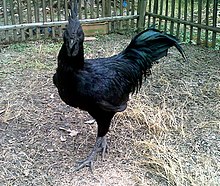Ayam Cemani
 Cemani hen | |
| Country of origin | Indonesia |
|---|---|
| Traits | |
| Weight |
|
| Skin color | Black with a turquoise glow on the rooster neck side and tail. |
| Egg color | Tinted/cream/light blue |
| Comb type | Single |
| Classification | |
| |

The Ayam Cemani is a rare breed of chicken from Indonesia. They have a dominant gene that causes hyperpigmentation (fibromelanosis), making the chicken mostly black, including feathers, beak, and internal organs. The Cemani is a very popular gamecock for cockfighting in Bali because their thighs have much more muscle compared to other chickens, which leads to them being much faster.[1]
Etymology
Ayam means "chicken" in Indonesian, while cemani (originally a Sanskrit word) means "thoroughly black" (down to the bones).[2]
Origin
As a pure Indonesian breed, the breed originated from the island of Java, Indonesia, and has probably been used since the 12th century for religious and mystical purposes.[3]
The breed was described by Dutch colonial settlers[4] and first imported to Europe in 1998 by Dutch breeder Jan Steverink.[citation needed] Currently, this breed of chicken is kept in the Netherlands, Belgium, Germany, Slovakia, Sweden, Italy and the Czech Republic. Ayam Cemani may have also been brought to Europe by Dutch seamen.
Description
The optimal standard is that their beaks, tongues, combs and wattles appear black, and even their meat, and organs are black or gray. However contrary to popular belief, their bones are not actually black. Their blood is normally colored. They are a medium sized chicken that are known for their beautiful and unique look. They are usually a somewhat friendly bird but they are still relatively skittish. The birds' black color occurs as a result of excess pigmentation of the tissues, caused by a genetic condition known as fibromelanosis.[5] Fibromelanosis is also found in some other black or blue-skinned chicken breeds, such as the Silkie.[6][7] The roosters weigh 2–2.5 kg (4.4–5.5 lb) and the hens 1.5–2 kg (3.3–4.4 lb). The hens lay tinted or cream-colored eggs, although they are poor setters and rarely hatch their own brood. Eggs weigh an average of 45 g (1.6 oz).
See also
References
- ^ Lukasiewicz, Monika (23 August 2014). "Meat quality and the histological structure of breast and leg muscles in Ayam Cemani chickens, Ayam Cemani × Sussex hybrids and slow‐growing Hubbard JA 957 chickens". Journal of the Science of Food and Agriculture. 95 (8): 1730–1735. doi:10.1002/jsfa.6883. PMID 25155871 – via SCI.
- ^ "Arti kata cemani - Kamus Besar Bahasa Indonesia (KBBI) Online". kbbi.web.id. Retrieved 2020-07-08.
- ^ Solly, Meilan (September 19, 2019), These Chickens Have Jet Black Hearts, Beaks and Bones, retrieved May 18, 2020
- ^ Lukanov, H.; Genchev, A. (September 2013). "Fibromelanosis in domestic chickens" (PDF). Agricultural Sciences and Technology. 5 (3): 239–246.
- ^ Shinomiya, Ai; Kayashima, Yasunari; Kinoshita, Keiji; Mizutani, Makoto; Namikawa, Takao; Matsuda, Yoichi; Akiyama, Toyoko (February 2012). "Gene Duplication of endothelin 3 Is Closely Correlated with the Hyperpigmentation of the Internal Organs (Fibromelanosis) in Silky Chickens". Genetics. 190 (2): 627–638. doi:10.1534/genetics.111.136705. PMC 3276631. PMID 22135351.
- ^ Dorshorst, Ben; Molin, Anna-Maja; Rubin, Carl-Johan; Johansson, Anna M.; Strömstedt, Lina; Pham, Manh-Hung; Chen, Chih-Feng; Hallböök, Finn; Ashwell, Chris; Andersson, Leif (December 2011). "A Complex Genomic Rearrangement Involving the Endothelin 3 Locus Causes Dermal Hyperpigmentation in the Chicken". PLOS Genetics. 7 (12): e1002412. doi:10.1371/journal.pgen.1002412. PMC 3245302. PMID 22216010.
- ^ Arora, G.; Mishra, S. K.; Nautiyal, B.; Pratap, S. O.; Gupta, A.; Beura, C. K.; Singh, D. P. (2011). "Genetics of hyperpigmentation associated with the Fibromelanosis gene (Fm) and analysis of growth and meat quality traits in crosses of native Indian Kadaknath chickens and non-indigenous breeds". British Poultry Science. 52 (6): 675–685. doi:10.1080/00071668.2011.635637. PMID 22221233. S2CID 25423912.
- Articles with short description
- Short description is different from Wikidata
- Articles containing Indonesian-language text
- Articles containing Javanese-language text
- All articles with unsourced statements
- Articles with unsourced statements from October 2023
- Chicken breeds
- Chicken breeds originating in Indonesia